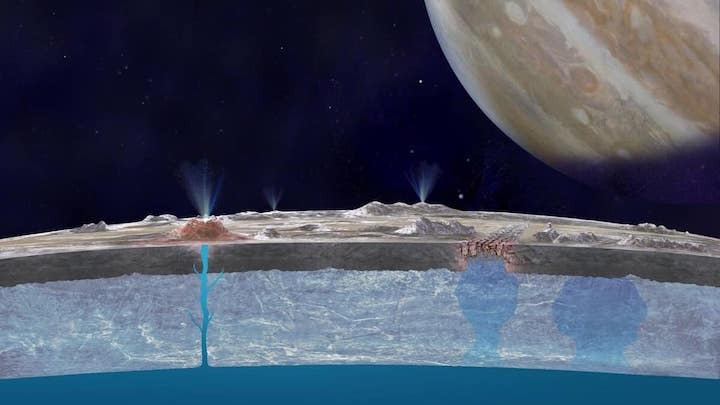29.03.2022

On Jupiter’s moon Europa, ‘chaos terrains’ could be shuttling oxygen to ocean
Jupiter’s moon Europa is a top contender when looking for alien life because scientists have detected signs of oxygen, water, and chemicals that could be used as nutrients there. However problematically the vast liquid water ocean on its surface is covered by a crust of ice – estimated to be about 15 to 25 kilometres thick – that acts as a barrier between it and oxygen on the surface.
For life as we know it to exist in the ocean it needs oxygen, and it could be hitching a ride on salt water under the ‘chaos terrains’ of the icy shell, according to a new study published in Geophysical Research Letters.
‘Chaos terrains’ are landscapes of cracks, ridges, and ice blocks that cover a quarter of Europa, and which scientists think form when the ice shell partially melts to form brine. This brine can then mix with the oxygen at the surface and drain through the ice into the ocean below.
Researchers built the world’s first physics-based computer simulation of the phenomenon and have shown that the brine drains in a distinctive manner, taking the form of a ‘porosity wave’ that causes pores in the ice to momentarily widen – allowing the brine to pass through – before sealing back up.
The researchers say that the highest estimates of the oxygen brought to Europa’s ocean could be on par with what’s present in Earth’s oceans today.

The physics-based model built by the researchers shows brine and oxygen at Europa’s surface being carried by a “porosity wave” (spherical shape) through the moon’s ice shell to the liquid water ocean below. The chart shows time (in thousands of years) and ice shell depth (in kilometers). Red indicates higher levels of oxygen. Blue represents lower levels of oxygen. Credit: Hesse et al.
Quelle: COSMOS
